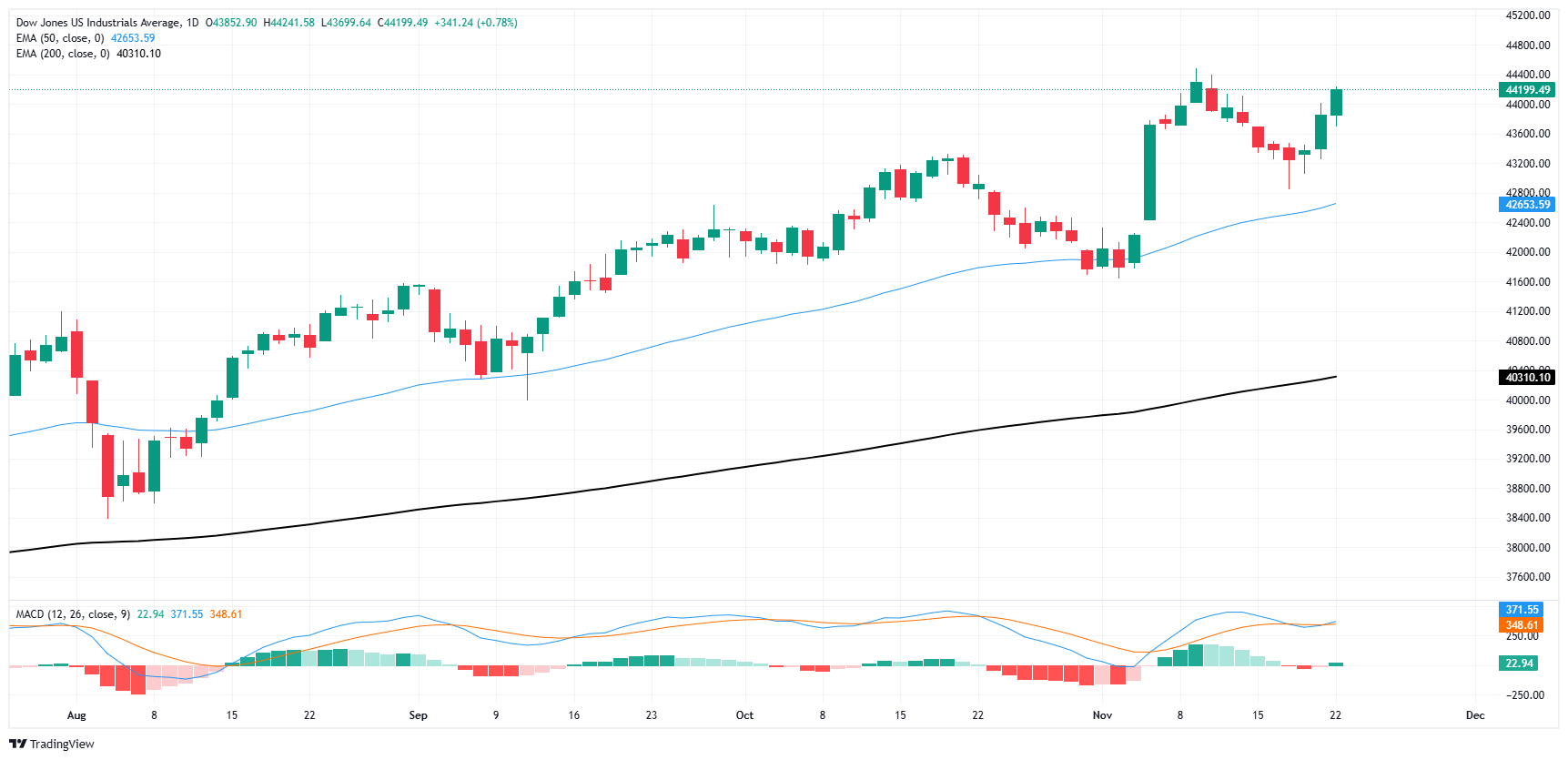- The Dow Jones gained another 400 points on Friday.
- After a brief lull, the major index is back into its post-election rally.
- Investors are pivoting out of the usual tech rally into consumer goods.
The Dow Jones Industrial Average (DJIA) has snapped its recent soft patch, extending its midweek bullish pivot into a firm Friday performance. The Dow Jones is on its way to finishing another trading week on the firmly bullish side, up around 1.8% from Monday’s opening bids but still a little shy of last week’s record highs near 44,485.
A firm print in US Purchasing Managers Index (PMI) figures helped to bolster investor sentiment on Friday. November’s Manufacturing PMI exceeded expectations, printing at 48.8 compared to October’s 48.5. The Services PMI component handily outperformed forecasts, coming in at 57.0. Median market forecasts called for a more sedate uptick to 55.3 from the previous month’s 55.0.
Despite the upbeat print in PMI business activity expectations, consumer sentiment surveys threw up a warning flag: the University of Michigan’s (UoM) Consumer Sentiment Index for November declined to 71.8 from the previous month’s 73.0, entirely missing an expected step upwards to 73.7. UoM 5-year Consumer Inflation Expectations also accelerated in November, and surveyed consumers now expect 5-year inflation to reach 3.2%, climbing from the expected hold at 3.1%.
Dow Jones news
The Dow Jones is seeing a wide sweep of bullish momentum on Friday, with all but five of the securities listed on the major index testing higher on the last day of trading for the week. Across the sector space, telecoms and tech companies are on the soft side, with industrials, consumer discretionaries, and financials finding the high side of the boards.
Tech sector investors have decided that Nvidia’s (NVDA) 93% YoY earnings growth in the third quarter wasn’t enough to keep bids on the high end; NVDA is down over 3% on Friday and trading at $142 per share. Boeing rose over 4.5% on Friday, testing into $150 per share as investors pick up the airplane manufacturer and developer with eyes on the company’s backlog of customer orders worth an estimated $500 billion. The company’s ability to execute on those orders has apparently not factored into the equation, with at least two plane models under FAA review. Boeing also has plans on the books for the company to axe 17,000 workers or ten percent of its entire workforce.
Dow Jones price forecast
Dow Jones bulls continue to keep prices elevated and out of harm’s way of any meaningful bearish technical signals. The major equity index is up around 5.8% in November, the index’s best-performing month to-date, and has added a tidy 18% from 2024’s opening bids.
One-sided bullish price action is marching back toward the 44,400 level, with the index’s latest pullback pricing in a soft technical floor near 43,200. Near-term momentum has a hard barrier priced in at the 50-day Exponential Moving Average (EMA) near 42,650.
Dow Jones daily chart
Dow Jones FAQs
The Dow Jones Industrial Average, one of the oldest stock market indices in the world, is compiled of the 30 most traded stocks in the US. The index is price-weighted rather than weighted by capitalization. It is calculated by summing the prices of the constituent stocks and dividing them by a factor, currently 0.152. The index was founded by Charles Dow, who also founded the Wall Street Journal. In later years it has been criticized for not being broadly representative enough because it only tracks 30 conglomerates, unlike broader indices such as the S&P 500.
Many different factors drive the Dow Jones Industrial Average (DJIA). The aggregate performance of the component companies revealed in quarterly company earnings reports is the main one. US and global macroeconomic data also contributes as it impacts on investor sentiment. The level of interest rates, set by the Federal Reserve (Fed), also influences the DJIA as it affects the cost of credit, on which many corporations are heavily reliant. Therefore, inflation can be a major driver as well as other metrics which impact the Fed decisions.
Dow Theory is a method for identifying the primary trend of the stock market developed by Charles Dow. A key step is to compare the direction of the Dow Jones Industrial Average (DJIA) and the Dow Jones Transportation Average (DJTA) and only follow trends where both are moving in the same direction. Volume is a confirmatory criteria. The theory uses elements of peak and trough analysis. Dow’s theory posits three trend phases: accumulation, when smart money starts buying or selling; public participation, when the wider public joins in; and distribution, when the smart money exits.
There are a number of ways to trade the DJIA. One is to use ETFs which allow investors to trade the DJIA as a single security, rather than having to buy shares in all 30 constituent companies. A leading example is the SPDR Dow Jones Industrial Average ETF (DIA). DJIA futures contracts enable traders to speculate on the future value of the index and Options provide the right, but not the obligation, to buy or sell the index at a predetermined price in the future. Mutual funds enable investors to buy a share of a diversified portfolio of DJIA stocks thus providing exposure to the overall index.
Information on these pages contains forward-looking statements that involve risks and uncertainties. Markets and instruments profiled on this page are for informational purposes only and should not in any way come across as a recommendation to buy or sell in these assets. You should do your own thorough research before making any investment decisions. FXStreet does not in any way guarantee that this information is free from mistakes, errors, or material misstatements. It also does not guarantee that this information is of a timely nature. Investing in Open Markets involves a great deal of risk, including the loss of all or a portion of your investment, as well as emotional distress. All risks, losses and costs associated with investing, including total loss of principal, are your responsibility. The views and opinions expressed in this article are those of the authors and do not necessarily reflect the official policy or position of FXStreet nor its advertisers. The author will not be held responsible for information that is found at the end of links posted on this page.
If not otherwise explicitly mentioned in the body of the article, at the time of writing, the author has no position in any stock mentioned in this article and no business relationship with any company mentioned. The author has not received compensation for writing this article, other than from FXStreet.
FXStreet and the author do not provide personalized recommendations. The author makes no representations as to the accuracy, completeness, or suitability of this information. FXStreet and the author will not be liable for any errors, omissions or any losses, injuries or damages arising from this information and its display or use. Errors and omissions excepted.
The author and FXStreet are not registered investment advisors and nothing in this article is intended to be investment advice.
Recommended content
Editors’ Picks

EUR/USD recovers toward 1.0500 after mixed US PMI data
EUR/USD rebounds toward 1.0500 in the American session on Friday after the data from the US showed that the business activity in the private sector expanded at a softer pace than anticipated in early February. The pair remains on track to end the week with little changed.

GBP/USD rises above 1.2650, looks to post weekly gains
GBP/USD regains its traction and trades above 1.2650 in the second half of the day on Friday. The data from the US showed that the S&P Global Services PMI dropped into the contraction territory below 50 in February, causing the US Dollar to lose strength and helping the pair edge higher.

Gold holds above $2,930 as US yields edge lower
Gold holds above $2,930 after correcting from the record-high it set above $2,950 on Thursday. Following the mixed PMI data from the US, the benchmark 10-year US Treasury bond yield stays in negative territory below 4.5% and allows XAU/USD to hold its ground.

Crypto exchange Bybit hacked for $1.4 billion worth of ETH
Following a security breach first spotted by crypto investigator ZachXBT, crypto exchange Bybit announced that it suffered a hack where an attacker compromised one of its ETH wallets.

Money market outlook 2025: Trends and dynamics in the Eurozone, US, and UK
We delve into the world of money market funds. Distinct dynamics are at play in the US, eurozone, and UK. In the US, repo rates are more attractive, and bills are expected to appreciate. It's also worth noting that the Fed might cut rates more than anticipated, similar to the UK. In the eurozone, unsecured rates remain elevated.

The Best brokers to trade EUR/USD
SPONSORED Discover the top brokers for trading EUR/USD in 2025. Our list features brokers with competitive spreads, fast execution, and powerful platforms. Whether you're a beginner or an expert, find the right partner to navigate the dynamic Forex market.